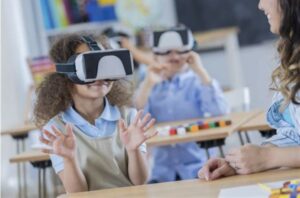What Tools Do You Need For Virtual Reality In Education?
Introduction
Virtual reality (VR) technology is rapidly changing the landscape of education and is becoming an increasingly popular tool for schools, universities, and other learning institutions. Virtual reality provides an immersive, engaging, and interactive learning environment, allowing students to explore new ideas, experiment with complex concepts, and gain experience in different fields. In this article, we will explore the tools and resources you need to create and implement a successful virtual reality program in your educational setting.
Hardware
The hardware needed to run a virtual reality program in an educational setting depends on the type of experience you are looking to create. For basic VR applications, such as simulations and interactive learning experiences, you will need a computer or laptop with a powerful GPU, a VR headset, and a compatible controller. For more immersive experiences, such as virtual field trips, you will need more advanced hardware, such as motion tracking systems, haptic feedback controllers, and advanced sensors.
Software
In addition to the hardware, you will need to have the right software to create and deliver virtual reality experiences. For simple simulations and interactive experiences, you will need a game engine such as Unity or Unreal Engine. For more complex projects, such as virtual field trips, you may need to use specialized software such as Google Earth VR or Oculus Medium.
Content Creation
Once you have the hardware and software in place, you will need to create the content for your virtual reality program. This can be done through a variety of methods, such as 3D modeling, video editing, and animation. You can also use existing content such as images, video, and audio to create immersive experiences. Additionally, you can use virtual reality applications such as Tilt Brush and Quill to create interactive 3D experiences.
Training
Finally, you will need to provide training for the teachers and students in your educational setting. This will involve teaching them how to use the hardware and software, as well as helping them understand the concepts and principles of virtual reality. It is also important to provide ongoing support and guidance to ensure your virtual reality program is successful.
How I’m Using Virtual Reality in Education
The Impact of Virtual Reality on Education
In the year 2023, virtual reality has become an integral part of education. It has been used to create immersive learning experiences, which has led to improved student engagement and better learning outcomes. Virtual reality also allows students to experience topics in a more realistic way, which can help foster a deeper understanding. Additionally, virtual reality can be used to help teach students in remote areas who may not have access to traditional classrooms.
The Benefits of Virtual Reality in Education
Virtual reality can provide a number of benefits to students and teachers. For example, it can help reduce the amount of time spent on mundane tasks, such as taking notes or writing essays. It can also help create a more engaging learning environment, as students can interact with virtual objects and environments. Furthermore, virtual reality can be used to simulate real-world scenarios, which can help students gain valuable experience before entering the workforce.
Using Virtual Reality in the Classroom
In the classroom, virtual reality can be used in a variety of ways. For example, it can be used to create interactive 3D models of complex concepts. It can also be used to create a realistic environment for students to explore and learn in. Additionally, virtual reality can be used to create virtual field trips, allowing students to explore distant locations without leaving the classroom.
Using Virtual Reality for Remote Learning
Virtual reality can also be used for remote learning. For example, it can be used to give students in remote locations access to virtual classrooms, where they can interact with teachers and other students. Additionally, virtual reality can be used to create simulations that allow students to practice skills in a safe environment. This can help increase student engagement and improve learning outcomes.
Conclusion
In the year 2023, virtual reality has become an invaluable tool for educators. It can be used to create immersive learning experiences, reduce the amount of time spent on mundane tasks, and create realistic simulations for remote learning. Virtual reality can also be used to create interactive 3D models and virtual field trips, allowing students to explore and learn in a more engaging way. Therefore, it is clear that virtual reality is having a profound impact on ed

